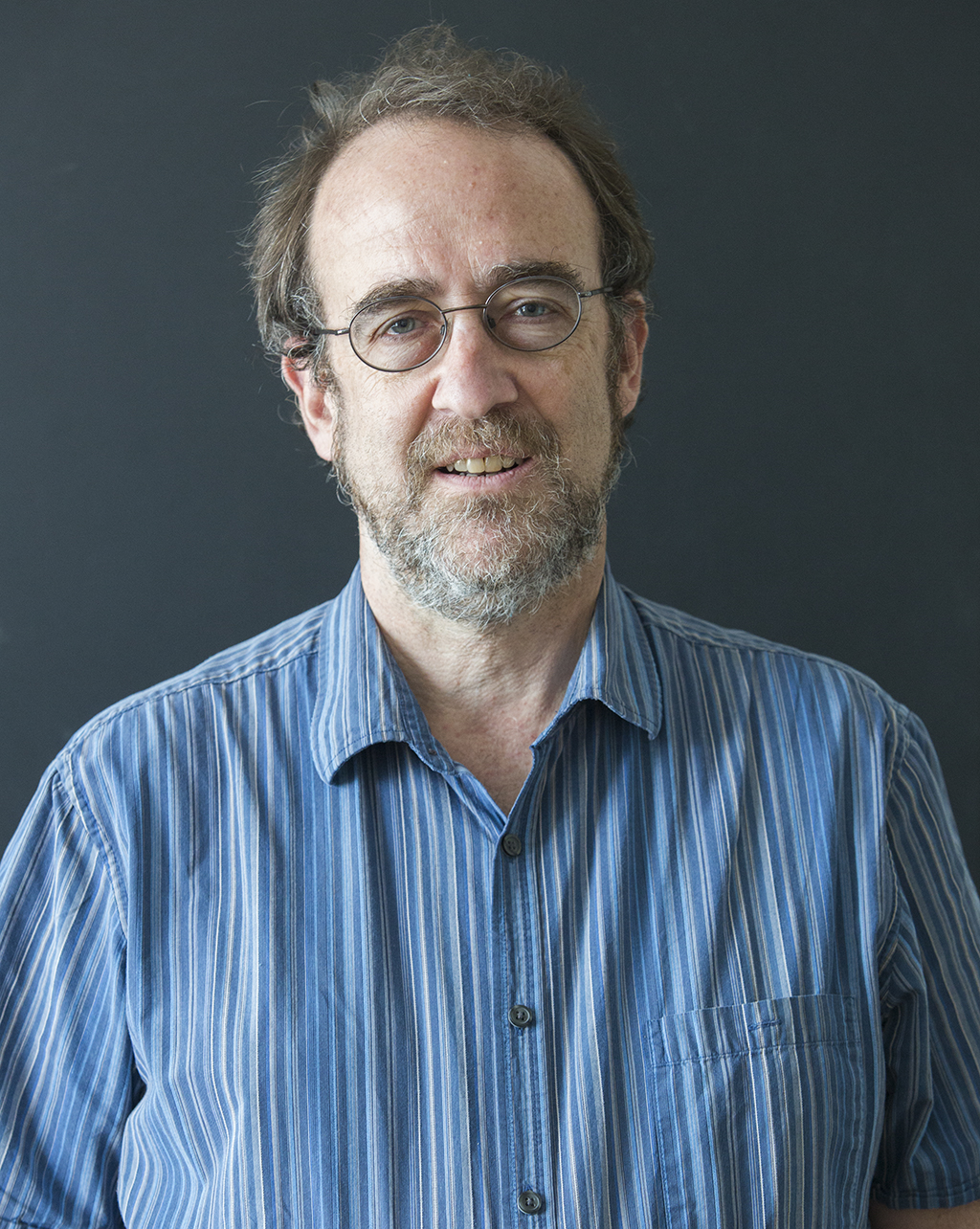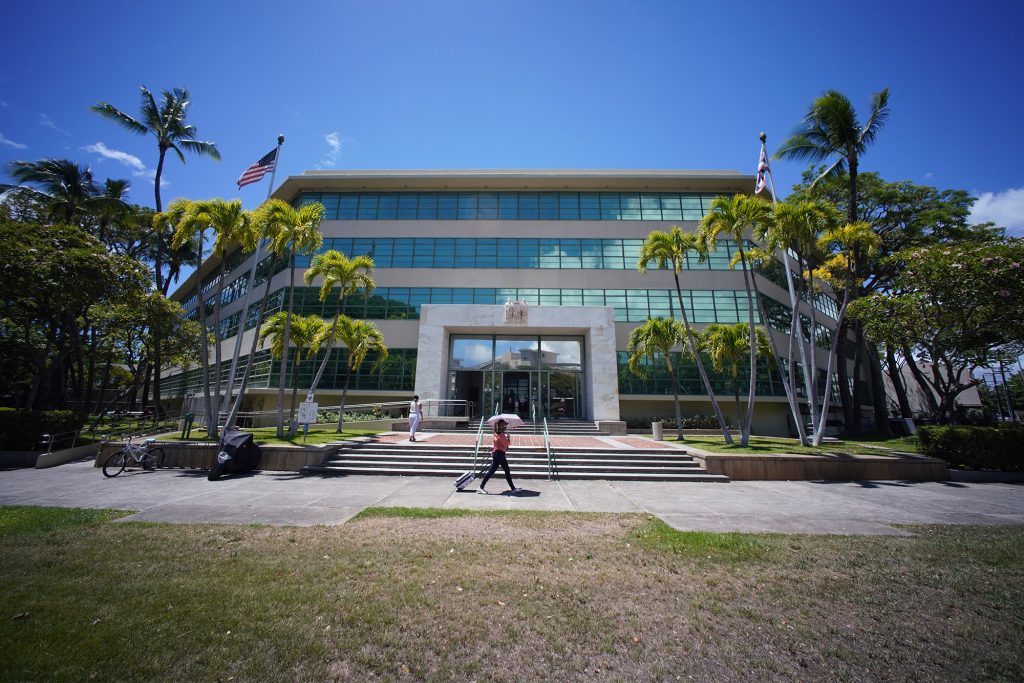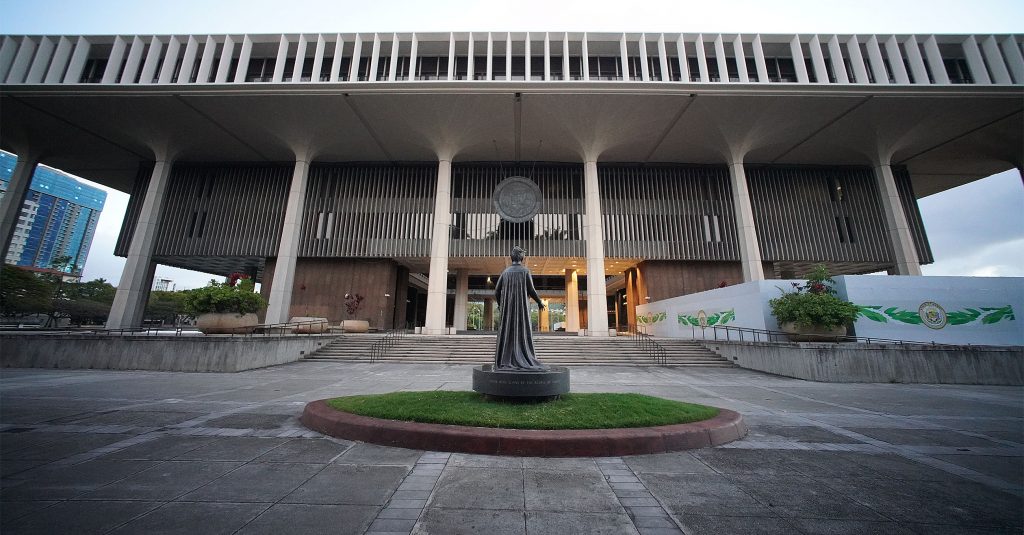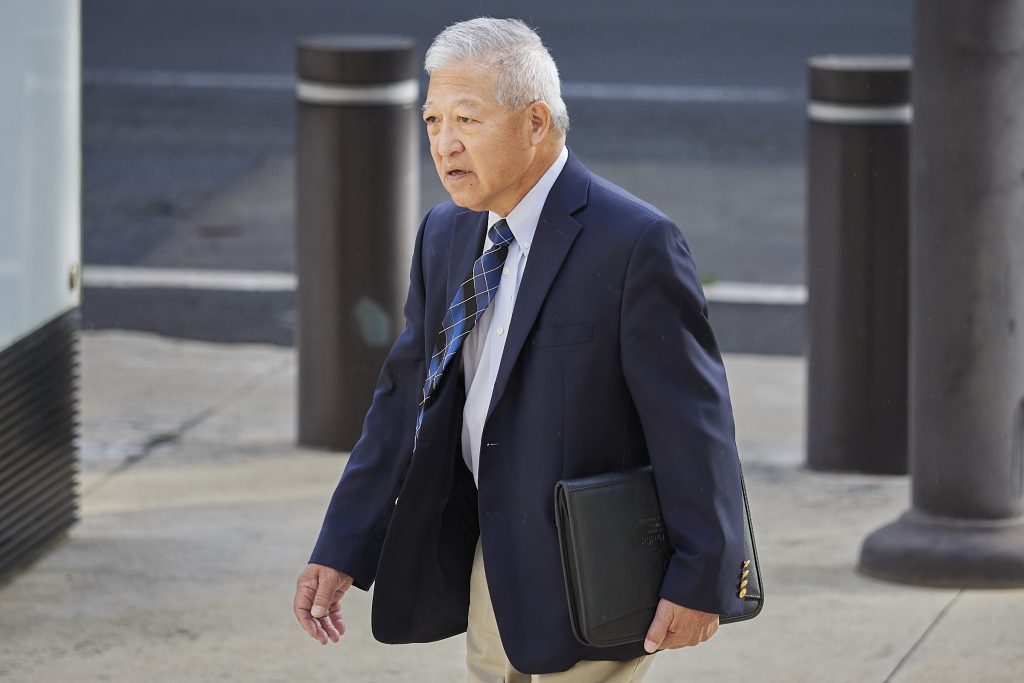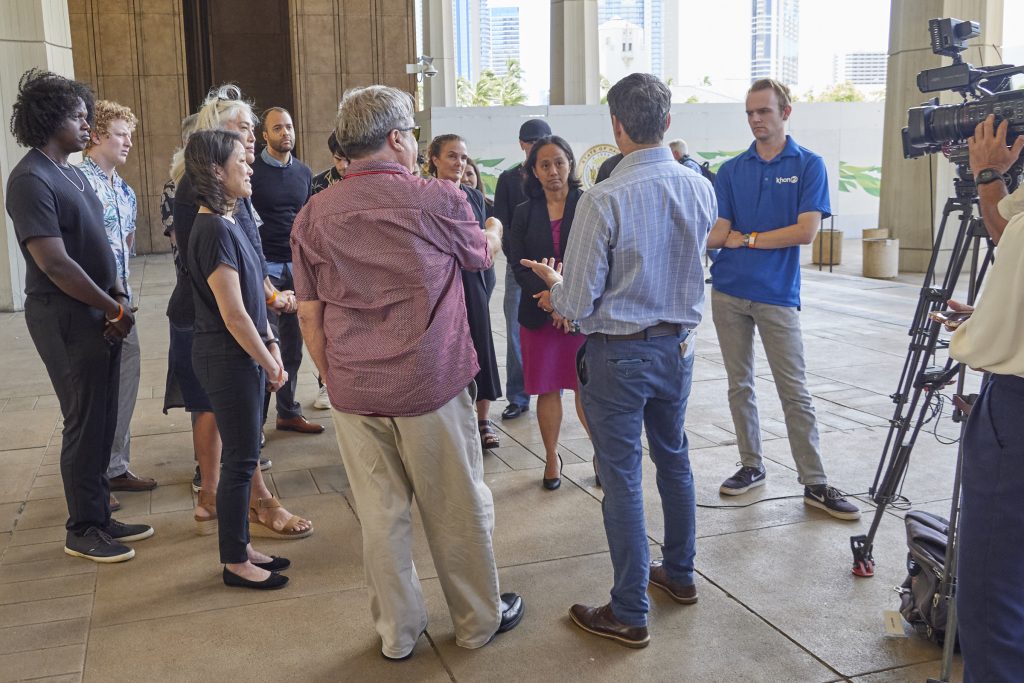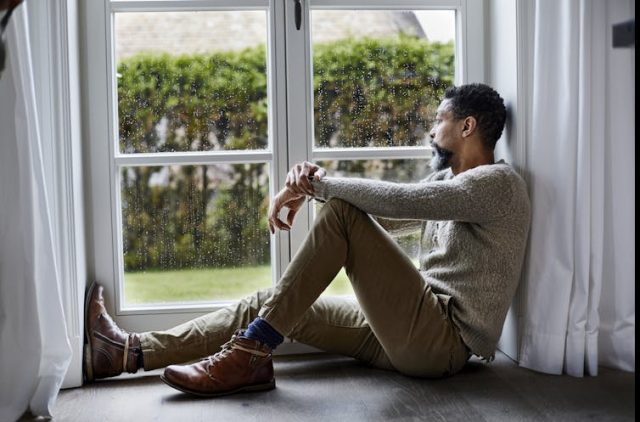Two years ago, someone almost killed Peyton Valiente.
The toddler, 17 months old at the time, arrived by ambulance at Pali Momi Medical Center in Honolulu on Jan. 9, 2015, his legs and arms stiff in the aftermath of seizures. A CT scan showed that he had a big subdural hematoma — a dangerous build-up of blood in the brain likely caused by a blow to the head.
His brain had shifted 1.3 centimeters from its normal center line.
Doctors transferred him to The Queen’s Medical Center for emergency surgery to relieve pressure by cutting out part of his skull.
They noted bruises on his back suggestive of hand prints. A later test showed extensive bleeding in his retinas, which can be caused by shaking or a severe impact.
“The child has been exposed to neglect and physical abuse,” a social worker for the state’s Child Welfare Services wrote a few days later in a court document. “The current abuse and neglect is severe.”

Two years later, Peyton, now 3, seems to be doing well. He plays a toy drum set, adores Bruno Mars songs and can make a shaka sign. But the lasting effects of the trauma remain uncertain.
No one has ever been held accountable for assaulting the toddler. And the Honolulu Police Department’s investigation, which eventually focused on the wife of one of its officers and their two teenage children who were at the in-home day care where Peyton was injured, fell far short of what experts recommend in such cases.
Interviews that ideally should have been done right away took months, according to the police report. Investigators apparently didn’t talk to other children at the day care. It’s unclear from the police report that they ever visited the scene.
The Ewa Beach in-home day care where Peyton was apparently injured was run by Manuela Ramos, the wife of HPD Cpl. Mark Ramos. Her two children, 18-year-old Theresa and 16-year-old Markus, also were there at the time.
According to reports, Manuela and Theresa Ramos told detectives that Manuela was the only one caring for Peyton and three other children. Manuela said that nothing unusual happened until Peyton suddenly became unresponsive for no apparent reason.
Police eventually submitted the first-degree assault case to the office of Honolulu Prosecuting Attorney Keith Kaneshiro. But prosecutors turned it down, concluding that no admissible evidence isolated any one suspect.
Peyton’s parents, Rey and Chelsea Valiente, say they can’t understand why no one has faced consequences in a clear-cut and severe case of child abuse.
Civil Beat contacted three widely recognized experts in child abuse investigations. None had firsthand knowledge of Peyton’s case, but all three described protocols most likely to lead to a conviction that HPD failed to follow.
Experts say investigators should talk to all those who had access to an abused child as soon as possible, preferably within a day, and look for inconsistencies in their accounts.
The police talked to Manuela Ramos shortly after the incident. But it would be several months before they interviewed her daughter or son. It would be that long, too, before the main detectives assigned to the case, from HPD’s child and family violence detail, did a second interview with Manuela Ramos.
A meeting with Ramos’ son, Markus, was put off for weeks while he finished the school year and attended a baseball tournament on the mainland, according to the police report.
“It’s sad that there’s no justice for Peyton.” — Chelsea Valiente, Peyton’s mother
Chelsea Valiente told Civil Beat that the day after her son was hurt, a Honolulu detective interviewing her at the hospital took a call from the police corporal and his wife.
Valiente recalls that the detective told his HPD colleague that the wife shouldn’t worry, that the investigation was just protocol.
Manuela Ramos, reached by phone, declined to talk to Civil Beat. HPD did not respond to a request to make Mark Ramos available for an interview.
The police report on Peyton’s assault does not indicate that the police ever spoke to the other children at the day care at the time, including a 9-year-old boy and girls ages 6 and 3. Interviews with even very young children, done correctly, can yield valuable information, experts say.
Likewise, the report does not indicate that police ever examined the Ramos house where Peyton most probably was injured.
An HPD spokeswoman wrote in an email that detectives try to gather as much information as possible before conducting interviews.
“Investigations can take several months or longer depending on the number of parties involved and the nature and complexity of the case,” HPD spokeswoman Sarah Yoro wrote.
HPD is reviewing the case, Yoro wrote.
The department did not respond to specific questions about why the other children at the day care apparently were not interviewed or whether they were screened for signs of abuse. Likewise, HPD did not say whether it would be proper for a detective to assure an HPD colleague that a case involving his wife was just protocol or whether investigators ever examined the scene of the apparent assault.
For Peyton’s parents, the ordeal of almost losing their only child has been magnified by how the case was handled.
They lost custody for two weeks while authorities ruled them out as the perpetrators.
As their son recovered in the intensive care unit, they were told that they might not get him back for a year at the earliest and to prepare for the likelihood that he would be released from the hospital to strangers.
“It was a devastating time,” Chelsea Valiente said. “I really thought it was a nightmare to have custody taken away. It was just the lowest point of our lives.”

After Peyton had gotten through the worst of his medical challenges, the Valientes had to face the conclusion of child abuse professionals that someone had assaulted him.
They held off on having other children, wanting first to see how much attention Peyton needed to get over his injuries. They also are reluctant to ever again rely on a stranger to look after their child. As a result, Chelsea Valiente said, they don’t get much time off together, staggering their schedules so that one is always with their son. Chelsea is now a registered nurse, while Rey works at a dialysis center.
“It’s sad that there’s no justice for Peyton,” Chelsea Valiente said. “He’s an innocent 1-and-a-half-year-old that suffered. … Up to this day, we don’t know what happened.”
The day Peyton was injured began uneventfully. He had started at Manuela Ramos’ day care in Ewa Beach a few days earlier. It was a small operation, where she cared for only a handful of children and so did not require a license from the state.
Chelsea Valiente dropped off Peyton at about 9 a.m. He seemed playful and alert, Valiente later told police, although he started crying at the day care, where he’d been left only two times before. Valiente found Ramos through a relative and hired her after interviewing three other babysitters. Ramos had been caring for children for 16 years.
Ramos told investigators that shortly before 3 p.m., Peyton, who had been lying on the ground near her, suddenly rolled to his side and became unresponsive, his legs and arms stiff. She told police that he had not fallen or gotten injured and that she did not notice any bumps or bruises.
She called Valiente to say that Peyton seemed to be having a hard time waking up. Valiente told her to call 911 right away and rushed to Ramos’ house to meet the ambulance.
“It is not clear why Mrs. Ramos did not call EMS herself,” a panel of child abuse experts convened to make recommendations to the state wrote in its report to Child Welfare Services.
Two doctors at the hospitals where Peyton was treated wrote in medical assessments that he had been in danger of dying. Valiente said she was told that if medical care had been delayed another 30 minutes, he likely would have.
The panel, called a multidisciplinary team, concluded that Peyton must have been injured between his last feeding at about noon and 2:45 p.m., when Ramos called Valiente. Children with injuries as severe as his would not have been capable of eating.
The following day at about 3:40 a.m., as Peyton was recovering from his surgery, a social worker from Child Welfare Services took him into protective custody. This step is customary when a child has been injured and authorities have not yet determined if it happened at home or if the parents were involved.
Around that time, Chelsea Valiente recalls, HPD Detective Phillip Buchanan was recording an interview with her. He got a call from Manuela Ramos, she said, and switched off his recorder. The day care operator apparently passed off the phone to her husband, Cpl. Mark Ramos, Valiente said.
She said she heard Buchanan tell Mark Ramos that his wife shouldn’t worry, that the investigation was just protocol.
She said she confronted Buchanan after he hung up, telling him that she didn’t think it was appropriate to rule out the last person who’d been with Peyton before he was injured.
Six days after Peyton was rushed to the hospital, an assessment found that he couldn’t chew properly and had a choking cough when he tried to swallow. He stared into the distance and couldn’t hold his bottle. The reviewer found that the previously healthy toddler had severe developmental delays and moderate to severe limitations of function.
A few days after that, a neurologist spoke to the Valientes about the possible effects of a frontal lobe injury on Peyton’s behavior and cognition, including his ability to regulate mood and emotion.

On Jan. 27, 2015, a social worker from Child Welfare Services got in touch with Acting Detective Carl Grantham, who took over the case from Buchanan three days after the incident, according to the police report. HPD did not respond to a request to make Grantham and Buchanan available for interviews.
The social worker told Grantham that the multidisciplinary team had met that day and issued its report, which found that Peyton’s injuries most likely resulted from “non-accidental, abusive head trauma.”
The report added that the events “leading to his altered state suggest the harm occurred outside the care of the parents and most likely in the babysitter’s home.” It recommended that HPD interview the parents of the other children present that day to make sure they had not also been abused.
In a filing with the family court to restore custody to Peyton’s parents, Child Welfare Services officials wrote that the state “will not confirm Physical Abuse by parents, Rey and Chelsea Valiente, and confirm Physical Abuse by baby-sitter, Manuela Ramos.”
A week later, a state deputy attorney general wrote to the court that “the most likely perpetrator was the Child’s babysitter.”
But according to the police report, it would be another three to six months before detectives talked to Ramos’ two children, Theresa and Markus, and did a second interview with Manuela Ramos.
The police report provided to Civil Beat was blacked out in so many places that it is difficult to tell who was interviewed when. It appears that detectives talked to Manuela and Theresa Ramos in May or June. (However, at other points in the police report, the dates of the meetings are given as May 20, 2014 and June 14, 2013, both well before Peyton was injured.)
A person whose name is blacked out, who apparently accompanied either Manuela or Theresa to an interview, said that the best time to talk to Markus would be at the end of July, a month-and-a-half later.
“I would have started with the day care provider and the others who were present.” — Child abuse expert Beoncia Loveless
The interview with Markus, a standout high school pitcher recruited to play baseball at the University of Oregon, was scheduled for early August, but had to be canceled, according to the police report, “due to a trip off Island for a baseball tournament.”
On Aug. 12, 2015, HPD’s Grantham got a call that Markus Ramos had returned to Oahu. They finally talked, two weeks later, by phone.
“I can tell you that’s not best practice, in my opinion,” Beoncia Loveless, a child abuse expert, said when told about the delayed interviews.
Until recently, Loveless coordinated a child abuse investigations support center for the Georgia Bureau of Investigation and now serves as chair in forensic science at Southern Crescent Technical College. She has been qualified as a child abuse expert in court proceedings, and has lectured on and contributed to a book about the subject.
Loveless and other experts said that those who had access to an abused child should be separated and interviewed thoroughly as soon as possible.
“I would have started with the day care provider and the others who were present,” Loveless said. “I always start with the person who had immediate access to the child.”
Civil Beat described the case to Bradley Russ, director of the National Criminal Justice Center at Fox Valley Technical College in Wisconsin. Russ, a former police chief in New Hampshire, has an extensive history of advocating for abused children and training others in child protection.
Given that the injury was thought to have occurred at the day care, Russ said, “That would trigger a response by trained interrogators. … We would be separating all three people at the day care and trying to establish a timeline.”
He added, “All of those things would have happened in the first 24 hours.”
Mary Ashley, an assistant district attorney in San Bernardino County, California, who served as lead attorney in the agency’s family violence unit, agreed that a months-long delay would not constitute “best practices.” Investigators would not know whether potential suspects had compared notes or how well they might remember what happened that day.
Early statements are particularly important when more than one person had access to the child, she said, because inconsistencies in their stories might be the only way to pinpoint a suspect and get a conviction.
Asked about the delay in the Markus Ramos interview while he attended a baseball tournament, Ashley said, “That’s not ideal. You try to be courteous, but if you need to interview someone, you need to interview them, and sooner is better.”
Experts agree that it can be worthwhile to interview children, even very young ones.
As long ago as 1992, a child abuse investigation manual by the U.S. Department of Health and Human Services stated, “If other children are under the care of the same people, the investigator should talk with these children and perform, as appropriate, a screening for signs of physical injury. Other children should be asked about any injuries noted, as well as their observations about the injury on the alleged victim.”
The police report provided to Civil Beat does not indicate that HPD detectives made any attempt to interview the children, who were old enough to be verbal. It’s also not clear that HPD or any other agency screened the other children who attended Ramos’ day care for signs of abuse.
Likewise, the police report contains no mention of an examination of the scene. Even if there’s no physical evidence, sizing up the scene can help investigators determine if testimony makes sense, Ashley said. Could a fall, for instance, have happened the way a suspect described it?
The fact that the day care operator is married to a Honolulu police officer may pose a conflict, Ashley said.
Not only is Ramos married to an officer, her Facebook page lists at least six friends who are current or former employees of the department. One of those has exchanged “endorsements” for police expertise on the website LinkedIn with Buchanan, the first officer to investigate Peyton’s injuries.
To avoid a conflict, HPD could have turned to other agencies or its federal partners, Ashley said.
“All HPD employees are expected to adhere to the department’s policy that prohibits discrimination and favoritism toward any person,” HPD’s Yoro wrote. “Any employee found to be in violation is subject to disciplinary action.”
In September 2015, HPD submitted the results of its investigation to the Honolulu prosecuting attorney’s office. Eight months later, the office declined to take the case.
Chelsea Valiente said a prosecutor told her that, absent a confession from one of the three who were present, no one could be charged.
Chuck Parker, a spokesman for the prosecutor’s office, told Civil Beat that the HPD investigation yielded no admissible evidence isolating any one suspect.
“That did not sit well for us,” Valiente said. “Our son almost died.”
In January, just before the two-year limit for a civil action, the Valientes filed a lawsuit against Mark and Manuela Ramos.
Parker said the statute of limitations for first-degree assault is three years and that the case could be reopened before next January if new evidence comes to light.
 GET IN-DEPTH
REPORTING ON HAWAII’S BIGGEST ISSUES
GET IN-DEPTH
REPORTING ON HAWAII’S BIGGEST ISSUES
Civil Beat is a small nonprofit newsroom that provides free content with no paywall. That means readership growth alone can’t sustain our journalism.
The truth is that less than 1% of our monthly readers are financial supporters. To remain a viable business model for local news, we need a higher percentage of readers-turned-donors.
